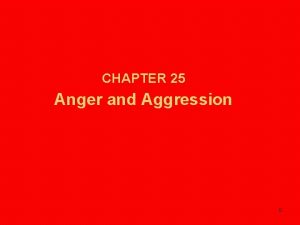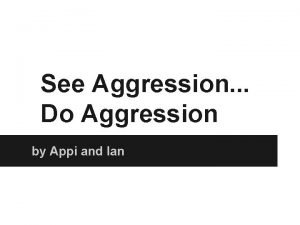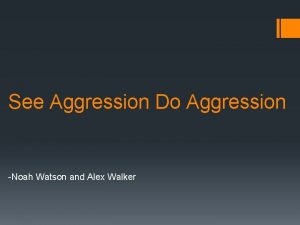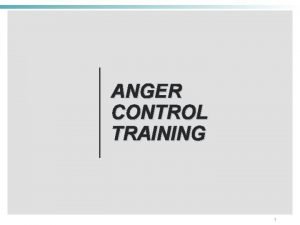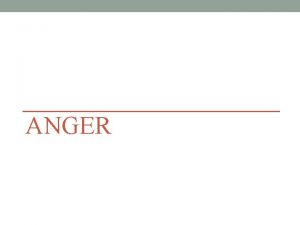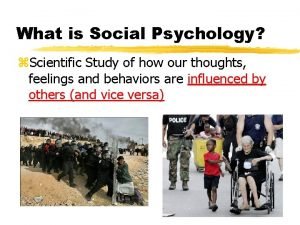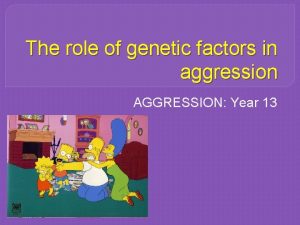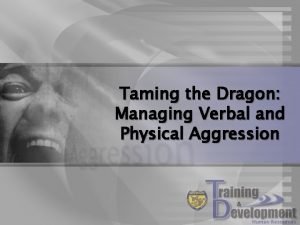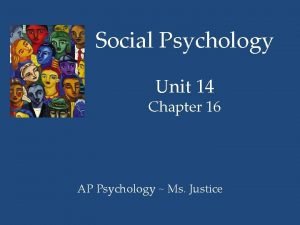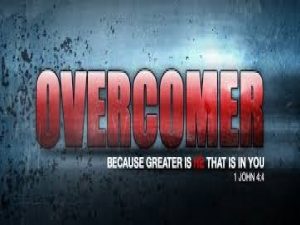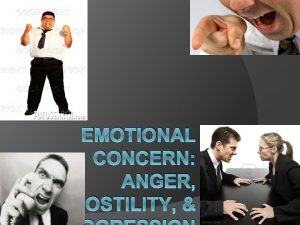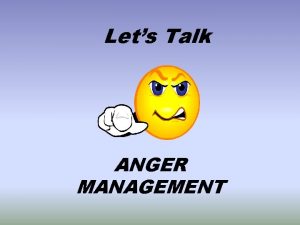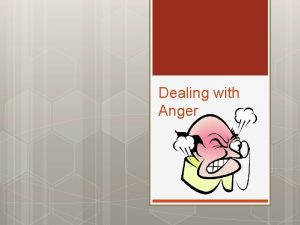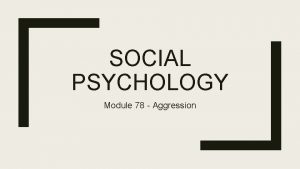Chapter 21 Anger and Aggression Anger and aggression











- Slides: 11

Chapter 21 Anger and Aggression

Anger and aggression n Anger ¨ Primal, not always logical-human emotion ¨ Varies in intensity from mild irritation to rage and fury Aggression ¨ Hostile reaction that occurs when control over anger is lost ¨ Used in attempt to regain control over stressor or flee situation ¨ Violence: refers to physical aggression Patients communicate increase anxiety before it escalates to anger, aggression, or violence: Remember-LISTEN TO THE PTS

Prevalence and community n n Anger and violence common aspects of social interaction Of the 1. 6 million violent deaths in US, ½ were suicides and 1/3 were homicides and 1/5 were casualties of war Persons with psych disorder 5 x more violent Medical & neurological causes of organic brain syndrome can result in agitated, aggressive or violent behavior

Theory n n n Anger stimulates hypothalamus causing body to react to anticipation of harm Heredity is a factor (males with XYY chromosome more prone) Selyes General Adaptation Syndrome ¨ Fight or Flight Freud’s Ego Defense Mechanisms ¨ Suggest mind can channel anger into socially acceptable ways Lewis ¨ Most important contributor is early & ongoing physical, sexual or emotional abuse

Theory n Neurobiological factors ¨ Brain structure: Limbic system-mediates primitive emotion & behaviors necessary for survival ¨ Neurotransmitters: cholinergic & catecholaminergic mechanisms involved in predatory aggression. Serotonergic and GABA modulate aggression ¨ Genetic Factors: twin studies proved genetic component to violence in addition to childhood violence

Cultural considerations n n n Violence is complex issue Socioeconomic, medical and psychiatric issues are contributing factors Substantial correlations between environment and aggression (poverty, unemployment, poor) Males are more violent than females Subculture supports intimidation & aggression as means of problem solving and achieving social status reinforces the use of violence (gangs)

Application of nursing process n Assessment ¨ Accurate, early can identify pt anxiety before it escalates to anger and aggression ¨ Leads directly to appropriate nursing diagnosis and intervention ¨ Expressions of anxiety and anger are similar (increased demands, pacing, irritability, frowning, red face, clenching of fists) ¨ On admission, obtain comprehensive history of pt gathered from variety of sources if possible ¨ Remember: patient history is a good predictor of risk for violence ¨ Assessment guidelines review

Application of nursing process n n n Diagnosis ¨ Patient safety is 1 st priority ¨ Risk for self directed violence and risk for other directed violence are primary nursing diagnosis ¨ If pt is escalating and not amenable to early nursing interventions or deescalating techniques then medication and/or restraints may be necessary Outcome Identification ¨ Inclusion of short, intermediate and long term goals Planning ¨ Necessitate sound assessment, including history (previous acts of violence, comorbid, disorders, present coping skills, alternative and nonviolent ways to handle anger (de-escalation techniques)

Application of nursing process n Implementation ¨ Ensure safety ¨ Stages of Violence Cycle n n n Pre-assaultive phase: de-escalation techniques Assaultive phase: Medication, Seclusions (involuntary confinement of pt alone in room), Restraint (refers to any manual method or mechanical device, material, or equipment attached or adjacent to patients body, restricts movement Post-assaultive phase: post seclusion/restraints staff should review the incident with pt and others

Application of nursing process n Implementation ¨ Critical Incident Debriefing; staff analysis of violent episode ¨ Documentation of violent episode ¨ Anticipated increased anxiety and anger in hospital settings ¨ Anxiety reduction techniques ¨ Interventions for patient with cognitive deficits n Catastrophic reaction; severe agitation and aggression including scream, cry or strike out due to fear ¨ Psychotherapy n Manage chronic aggression n Behavioral interventions n Cognitive behavioral approaches

Application of nursing process n Implementation ¨ Pharmacological, Biological & Integrative Therapies n Medications for acute aggression ¨ ¨ n Medications for chronic aggression ¨ ¨ ¨ n Atypical antipsychotics/ Typical antipsychotics Benzodiazepines Carbamazepine (Tegretol) Beta-blockers Buspar Lithium Anticonvulsants (Lamictal) Evaluation Care plan with specific outcome criteria and review essential ¨ Provides info about the extent to which interventions have achieved the outcomes ¨
 Chapter 27 anger aggression and violence
Chapter 27 anger aggression and violence 5 stages of aggression
5 stages of aggression See aggression do aggression
See aggression do aggression See aggression do aggression
See aggression do aggression Aggression replacement training anger control chain
Aggression replacement training anger control chain Anger vs aggression
Anger vs aggression Aggression replacement training anger control chain
Aggression replacement training anger control chain Social inhibition
Social inhibition Outline the role of genetic factors in aggression
Outline the role of genetic factors in aggression Examples of verbal aggression
Examples of verbal aggression Normative social influence ap psychology
Normative social influence ap psychology Social trap
Social trap

